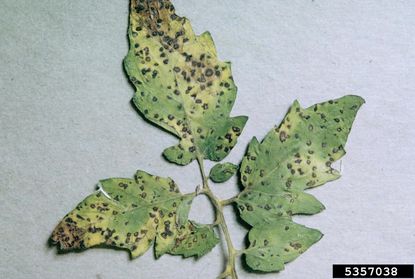Septoria Leaf Canker - Information On Controlling Septoria Leaf Spot On Tomatoes


Septoria leaf canker primarily affects tomato plants and members of its family. It is a leaf spot disease that is first evident on the oldest leaves of the plants. Septoria leaf blotch or canker may occur at any phase of the plant's development and is easy to recognize and distinguish from other leaf disorders. Wet conditions deposit the fungus Septoria on tomato leaves and warm temperatures cause it to bloom.
Identifying Septoria Leaf Canker
Septoria on tomato leaves manifests as water spots that are 1/16 to 1/4 inch (2-6 mm.) wide. As the spots mature, they have brown edges and lighter tan centers and become septoria leaf cankers. A magnifying glass would confirm the presence of small black fruiting bodies in the center of the spots. These fruiting bodies will ripen and explode and spread more fungal spores. The disease doesn't leave marks on the stems or fruit but does spread upward to younger foliage. Septoria leaf blotch or spot causes tomato plants to decline in vigor. The septoria leaf cankers cause so much stress to the leaves that they fall off. The lack of foliage will diminish the health of the tomato as it reduces the ability to gather solar energy. The disease progresses up the stems and causes all the leaves it infects to wither and die.
Septoria on Tomato Leaves and Other Solanaceous Plants
Septoria is not a fungus that lives in soil but on plant material. The fungus is also found on other plants in the nightshade family or Solanaceae. Jimsonweed is a common plant also called Datura. Horsenettle, ground cherry, and black nightshade are all in the same family as tomatoes, and the fungus can be found on their leaves, seeds, or even rhizomes.
Controlling Septoria Leaf Spot
Septoria is caused by a fungus, Septoria lycopersici, which overwinters in old tomato debris and on wild Solanaceous plants. The fungus is spread by wind and rain, and flourishes in temperatures of 60 to 80 degrees F. (16-27 C.). Controlling septoria leaf spot starts with good garden hygiene. Old plant material needs to be cleaned up, and it's best to plant tomatoes in a new location in the garden every year. One year rotations of tomato plants have been shown to be effective in preventing the disease. Treating septoria leaf spot disease after it appears is achieved with fungicides. The chemicals need to be applied on a seven to ten day schedule to be effective. Spraying begins after blossom drop when the first fruits are visible. The most commonly used chemicals are maneb and chlorothalonil, but there are other options available to the home gardener. Potassium bicarbonate, ziram, and copper products are a few other sprays useful against the fungus. Consult the label carefully for instructions on rate and method of application.
Gardening tips, videos, info and more delivered right to your inbox!
Sign up for the Gardening Know How newsletter today and receive a free download of our most popular eBook "How to Grow Delicious Tomatoes."

Bonnie Grant is a professional landscaper with a Certification in Urban Gardening. She has been gardening and writing for 15 years. A former professional chef, she has a passion for edible landscaping.
-
 How To Get Rid Of Mosquitoes In The Garden: 9 Natural Ways To Make Them Buzz Off!
How To Get Rid Of Mosquitoes In The Garden: 9 Natural Ways To Make Them Buzz Off!How to get rid of mosquitoes is on the minds of people in the summer in almost every region of the world. Learn how to repel the pests without toxic chemicals.
By Mary Ellen Ellis
-
 Monkey Orchid Care: How To Grow This Fascinating Species
Monkey Orchid Care: How To Grow This Fascinating SpeciesThe monkey orchid bears a remarkable resemblance to its namesake and, with a little know-how, can be successfully grown as a houseplant.
By Bonnie L. Grant